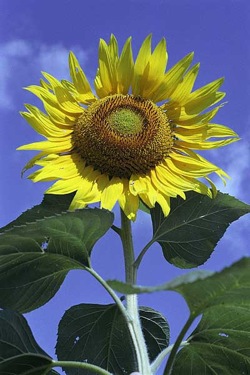Sunflowers: a muse for improving solar power


The sunflower may be the brightest muse for human invention. It inspired Van Gogh to paint an impressionist masterpiece, and is now guiding a scientist toward making possible more energy efficient solar power systems.
University of Wisconsin-Madison professor Hongrui Jiang took notice of how sunflowers follow the sun's movement through the day, and created a design that emulates how their leaves move to maximize light exposure through an adaptation called heliotropism.
Many high tech solar systems use GPS satellites to track the position of the sun. Jiang's design instead mimics a sunflower's natural engineering with a passive method to re-orienting solar panels in the direction of the sun. The design was published in the Aug. 1 edition of the journal Advanced Functional Materials.
Nature created leaves through eons of adaptation and mutation; Jiang combined a heat sensitive material called liquid crystalline elastomer (LCE) with carbon nanotubes that absorb light. "Carbon nanotubes have a very wide range of absorption, visible light all the way to infrared," Jiang said in a statement.
"That is something we can take advantage of, since it is possible to use sunlight to drive it directly," Jiang added. Watch for yourself:
The entire solar assembly bows in the direction of the strongest sunlight, and solar panels are repositioned to follow the sun over 180 degrees (as the sun rises and sets). This improved their solar efficiency by 10 percent in the lab. The absence of motors and electronic components contributed to the savings.
Sunflowers also inspired the work of researchers at Massachusetts Institute of Technology in collaboration with RWTH Aachen University in Germany. In January, the team published a paper outlining how to arrange mirrors to increase the amount of sunlight collected by replicating the spirals on the face of the flower.
This approach reduced the size of concentrated solar power units by 16 percent in addition to increasing its potential to collect sunlight. The researchers have applied for a patent (I'll resist the temptation of making a joke about 'prior art.')
Related:
- Germany's December solar tally: More than 2 gigawatts installed
- Solar-power Kindle cover debuts at CES
- The hottest solar markets in early 2012
- IEA: Solar could provide a third of the world's energy by 2060
- Another BrightSource solar thermal power plant project is on its way
- Breakthrough: world's most efficient solar panel
- Biologically inspired design: How sunflowers could reshape solar power
This post was originally published on Smartplanet.com